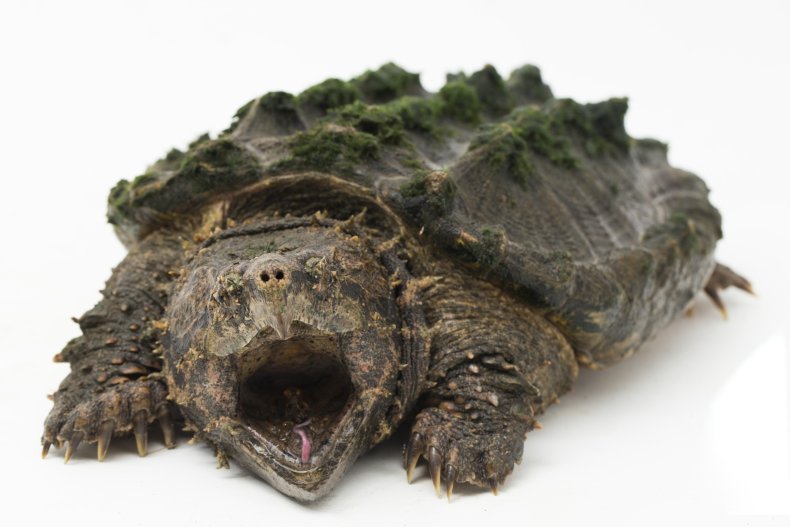There are many legends that tell of terrifying creatures lurking in the depths of the water, ranging from the Loch Ness monster to the kraken, an enormous mythical octopus.
But for the most part, it is obvious when they are entirely fabricated—and other times, it is not so clear.
Often dubbed the dinosaur of the turtle world, snapping turtles are certainly a sight to behold. The creatures, which can be found across the United States, are named as such because of their powerful bite.
A claim that a man-eating snapping turtle was lurking in an Indiana lake recently went viral on Facebook. Officials have even been part of the discussion.
But is it true?

The Claim
Kevin Goodman, of Judah, Indiana, posted to his Facebook page on Sunday night, claiming that forensic scientists from Purdue University had discovered "decapitated human remains" in Lake Monroe—Indiana's largest reservoir, about 10 miles southeast of Bloomington.
The reason? A gruesome attack by a giant snapping turtle, which is potentially "the largest ever recorded."
The post was shared widely, and received over 13,000 shares.
Goodman wrote of a Purdue University biologist said to be called Dr. Eric Paddlejack, who was allegedly involved in the discovery.
Paddlejack supposedly believed the ginormous turtle was up to 9 feet in diameter and around 300 years old.
"It's extremely rare for snapping turtles to inflict life-threatening injuries to humans," Paddlejack is quoted as saying. "But in this case, the size and age of the turtle suggest an aggressiveness that is beyond ordinary...We examined the nature of the wounds, the size, the pattern, and the spacing. They were consistent with an extraordinarily large snapping turtle."
A local sheriff's department spokesman was quoted advising residents to be "aware of their surroundings."
BLOOMINGTON, Ind. — Forensic scientists at Purdue University announced today that the decapitated human remains discovered in Lake Monroe last week appear to have been the result of a gruesome attack...
The Facts
Goodman's post was so widely shared that officials eventually decided they had to weigh in.
Joani Stalcup, a Monroe County Coroner, said in a Facebook post that the story was "totally fabricated."
"There have been no remains found, no giant snapping turtle found and I am only assuming someone wanted to get their 10 mins of Facebook fame by making up such a story. There is no Purdue forensic specialist named Dr. Paddlejack either," Stalcup said. "If you cannot find a reputable source to confirm a post made by an individual chances are, the post is just a hoax. Just because someone puts it out on social media does not make it true."
I am making this post public so that anyone who wants to share it can.The story about a supposed 300 year old 9 ft snapping turtle taking a life at Lake Monroe in Bloomington, IN and the remains...
The Purdue University directory does not list anyone by the name of Paddlejack. University spokesperson Tim Doty told USA Today there is no such employee and that the university did not make the announcement. Newsweek has asked Purdue University for comment.
Snapping turtles—including the alligator snapping turtles and the common snapping turtle—do indeed live in many freshwater habitats throughout the U.S.
However while they can grow large, live for a long time, and also possess a strong set of jaws, both types of snapping turtles are not aggressive.
Alligator snapping turtles tend to have a more menacing appearance, with a jagged shell, larger head and beak-like jaws. They can be territorial, however will never attack a human unless directly provoked. Even then, it would be virtually impossible for them to kill a person. There have been no recorded deaths from a snapping turtle.
The creatures live for around 100 years, at most, although the average lifespan in the wild is around 20 to 70 years, according to National Geographic.
Alligator snapping turtles are the largest of all turtle species, but they usually only grow to around 2 feet, or slightly over.
The Fish and Wildlife division of the Indiana Department of Natural Resources (DNR) also debunked the story.
"Rest easy, there is NOT a giant man-eating snapping turtle in Monroe Lake," the department wrote on Facebook, according to Fox News. "The hoax Facebook post claiming a man had died from a snapping turtle attack is completely false and had over 16,000 shares—emphasizing the importance of checking sources when reading something shocking or out of ordinary."
Indiana DNR also took to Twitter to discount the story.
"FYI: If you're looking for turtles, we've got you covered. But if you're looking for a nine-foot, 300-year-old snapping turtle, you might try your favorite comic book or horror film instead of #MonroeLake," they said.
FYI: If you’re looking for turtles, we’ve got you covered. But if you’re looking for a nine-foot, 300-year-old snapping turtle, you might try your favorite comic book or horror film instead of #MonroeLake.🐢 pic.twitter.com/Lwhv1DpLLo
— Indiana DNR (@INdnrnews) July 17, 2023
Following the input from officials, Kevin Goodman took to Facebook once again, captioning the post "Why I did it."
In the post, he explains that for several years, he has joked about writing a screenplay similar to Lake Placid—a 1999 movie about a killer crocodile living in the lake.
"I liked the idea because snapping turtles are large primitive scary-looking creatures, and yet, to the best of my knowledge, the idea of man-eating snapping turtles is novel. But I felt it could be done with an air of plausibility," he wrote. "A few months ago, I developed the idea of writing a satire piece and submitting it to The Onion. I thought this would be a good test for proof-of-concept for a screenplay. The article I posted on my personal Facebook page was really meant for a handful of people who knew about my project."
WHY I DID ITI am Kevin Goodman; I wrote the Lake Monroe Snapping Turtle Story. No, it was not an experiment, BUT I applaud those who looked into my background and felt that was a possibility.For...
While Goodman admits he did want the post to go viral, and become widely shared, he didn't imagine this would happen through his personal Facebook page.
"I considered the article a draft, and I was looking for feedback and did not imagine it would escape my immediate circle of friends," Goodman wrote. "At any rate, the 24 hours of turtle panic has proven my story concept has value. Movie rights are for sale!"
Newsweek has asked Goodman for comment via Facebook.
Other Facebook users responded to the Facebook post, expressing surprise that people didn't realise it was untrue.
"I must admit I was very fascinated. Mostly I was fascinated that people didn't realize it was satire. Then I was fascinated about people who were upset about this fake news turtle story," one Facebook user commented.
The Ruling

False.
While they have a powerful bite, the story of a huge man-eating snapping turtle lurking in the depths of Lake Monroe is false.
If the debunking from officials wasn't enough, Goodman himself admitted it was nothing more than a concept for a movie.
FACT CHECK BY NEWSWEEK








